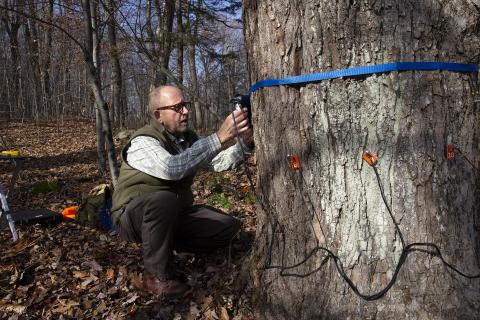
By Patrick Skahill
The latest national climate assessment says forests play a key role in keeping our air clean.
According to the report, America’s forests stored the equivalent of 11 percent of the country’s carbon dioxide emissions over a 25 year period. That’s because when trees breathe they suck up carbon dioxide, release oxygen, and store that leftover carbon in their trunks. But how scientists determine the amount of carbon stored in a tree is a question open for debate.
When Bob Marra goes into the woods, he takes a tool with him. It’s a hammer -- his magic sonic hammer.“It’s called a sonic hammer. But I call it the ‘magic’ sonic hammer, just because it looks kind of cool,” Marra said. Marra is a biologist with the Connecticut Agricultural Experiment Station. While the hammer isn’t magical, it did do something pretty cool: help us look inside a tree. To do that, Marra hammered nails into the trunk of a sugar maple in northwest Connecticut, girdling the tree with sensors. Then, he circled and tapped on each nail. Each tap was recorded by a computer.
Marra’s recording sound waves. Measuring how fast sound travels from the nail he hits, to all the other nails around the tree. It’s called “sonic tomography.” Think of it like a CAT scan for trees. A way to peer inside a trunk without drilling to see if a tree is rotting -- or solid wood. “The denser the wood, the faster the sound waves,” Marra said. Dense wood is really good at storing carbon. But if a tree is less dense inside, that could indicate decay. And also, that the tree might not be as good at storing carbon as we think.

